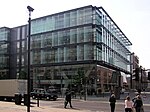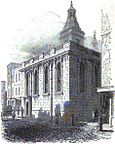College of Arms

The College of Arms, or Heralds' College, is a royal corporation consisting of professional officers of arms, with jurisdiction over England, Wales, Northern Ireland and some Commonwealth realms. The heralds are appointed by the British Sovereign and are delegated authority to act on behalf of the Crown in all matters of heraldry, the granting of new coats of arms, genealogical research and the recording of pedigrees. The College is also the official body responsible for matters relating to the flying of flags on land, and it maintains the official registers of flags and other national symbols. Though a part of the Royal Household of the United Kingdom, the College is self-financed, unsupported by any public funds. Founded by royal charter in 1484 by King Richard III, the College is one of the few remaining official heraldic authorities in Europe. Within the United Kingdom, there are two such authorities, the Court of the Lord Lyon in Scotland and the College of Arms for the rest of the United Kingdom. The College has had its home in the City of London since its foundation, and has been at its present location, on Queen Victoria Street, since 1555. The College of Arms also undertakes and consults on the planning of many ceremonial occasions such as coronations, state funerals, the annual Garter Service and the State Opening of Parliament. Heralds of the College accompany the sovereign on many of these occasions. The College comprises thirteen officers or heralds: three Kings of Arms, six Heralds of Arms and four Pursuivants of Arms. There are also seven officers extraordinary, who take part in ceremonial occasions but are not part of the College. The entire corporation is overseen by the Earl Marshal, a hereditary office always held by the Duke of Norfolk.
Excerpt from the Wikipedia article College of Arms (License: CC BY-SA 3.0, Authors, Images).College of Arms
Godliman Street, City of London
Geographical coordinates (GPS) Address External links Nearby Places Show on map
Geographical coordinates (GPS)
| Latitude | Longitude |
|---|---|
| N 51.512222222222 ° | E -0.098888888888889 ° |
Address
College of Arms
Godliman Street
EC4V 4BT City of London
England, United Kingdom
Open on Google Maps










